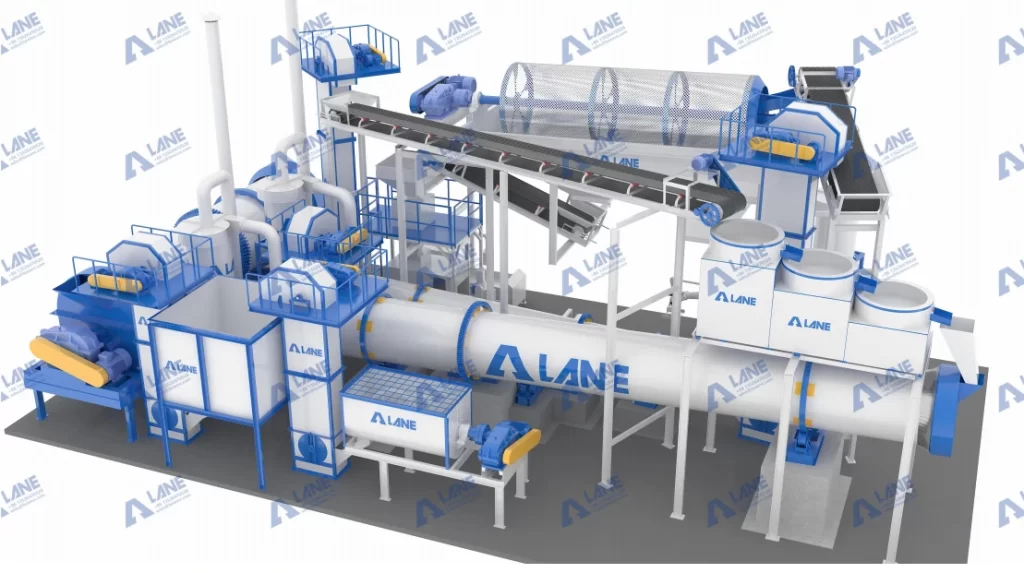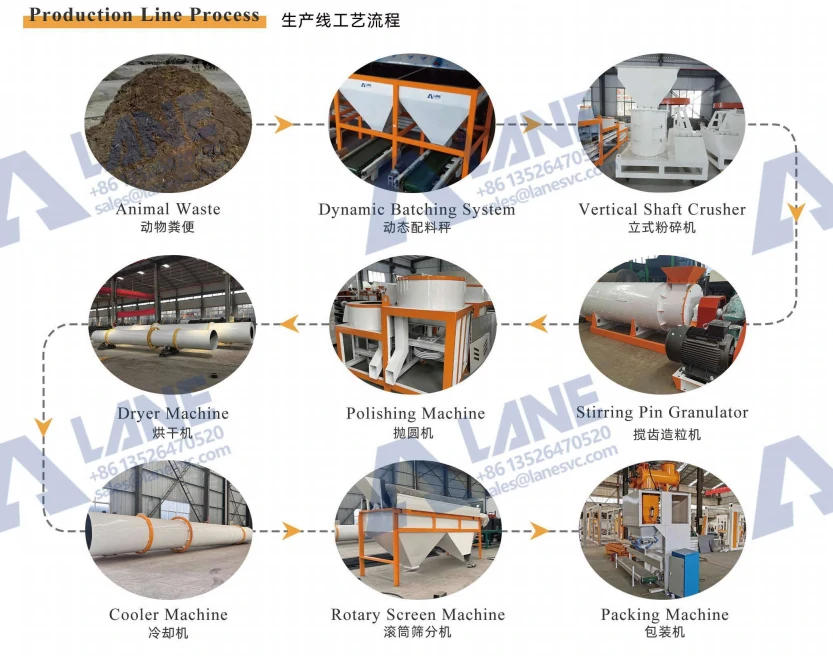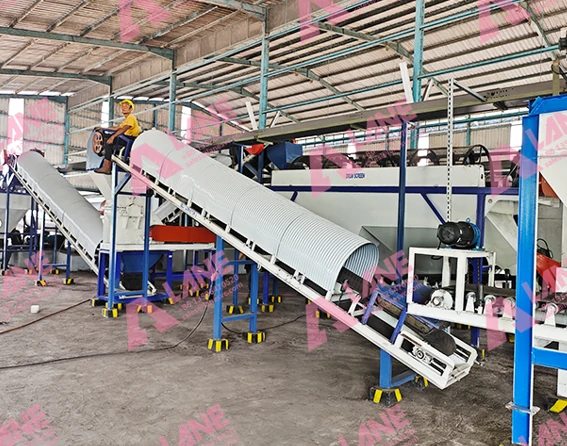The agriculture industry is at a crossroads. Farmers face the dual challenge of producing more food while reducing environmental impacts. Over-reliance on chemical fertilizers has caused soil degradation, nutrient imbalances, and ecological harm. Against this backdrop, algae have emerged as a remarkable alternative.
An algae-based fertilizer production line takes one of the planet’s oldest organisms and transforms it into a modern agricultural input. Algae are not only renewable and versatile but also rich in nutrients and growth-promoting compounds. Their application in fertilizer production offers a pathway toward soil regeneration, higher crop yields, and sustainable farming practices.
What makes this solution unique is the combination of marine biology and industrial engineering: using advanced machines to turn green or brown algae into liquid, powder, or granular fertilizers. The result is a circular, eco-friendly solution that connects oceans and fields.

Why Algae for Fertilizers?
Algae are no longer just associated with food supplements or biofuels. Their chemical and biological properties make them an outstanding resource for agriculture:
Comprehensive Nutrition: Algae naturally contain nitrogen, phosphorus, potassium, and trace minerals like magnesium, zinc, and iron. Unlike single-nutrient fertilizers, algae provide balanced nutrition.
Plant Growth Hormones: Algae are rich in cytokinins, auxins, and gibberellins—natural plant hormones that accelerate root initiation, shoot elongation, and flowering.
Stress Resistance: Studies show that crops treated with algae-based fertilizers withstand salinity, drought, and disease better than untreated crops.
Eco-Friendly Resource: Algae grow rapidly, even in marginal environments like saline ponds or wastewater, without competing with food crops for land.
Carbon Sequestration: Large-scale algae cultivation absorbs significant CO₂, directly contributing to climate mitigation.
Thus, an algae-based fertilizer production line is not just about producing fertilizer—it’s about creating a regenerative system where agriculture benefits from marine ecosystems.
Overview of an Algae-Based Fertilizer Production Line
The production line integrates biological raw material handling with industrial-scale processing. The general sequence looks like this:
1.Algae Cultivation and Harvesting
Algae are cultivated in ponds, open raceways, or closed photobioreactors. In coastal regions, wild macroalgae such as kelp are harvested using mechanical collection systems. Paddle wheels and pumps circulate water to ensure optimal growth.
2.Pre-Treatment and Dewatering
Fresh algae typically contain 85–90% water, making dewatering essential. An inclined dewatering machine or belt press reduces water content to 60–70%. Solar drying can further lower moisture in resource-limited regions.
3.Crushing and Mixing
The biomass is broken down using crushers to rupture cell walls, releasing nutrients. It is then blended in a horizontal mixer with carriers like humic acid, molasses, or trace minerals. This step tailors the final fertilizer formula to crop needs.
4.Fermentation or Extraction
For liquid fertilizers, fermentation tanks with microbial cultures or enzymatic extraction release soluble bioactive compounds.
For granules or powders, the crushed algae are dried and fed into a stirring pin granulator or rotary drum granulator to create uniform pellets.
5.Drying and Stabilization
Moisture is reduced further with a rotary drum dryer and cooler, ensuring shelf stability and preventing nutrient loss.
6.Screening and Filtration
Powder fertilizers are passed through a rotary screener, while liquid fertilizers are purified with a dual filter to remove impurities that could clog fertigation systems.
7.Packaging and Storage
Automatic packaging machines fill bottles, bags, or drums with precision. Products are labeled with nutrient content, batch number, and recommended usage, ensuring traceability and market readiness.
This multi-step algae-based fertilizer production line creates products that are safe, consistent, and scalable.

Different Product Forms from Algae-Based Fertilizer Production Lines
One of the strengths of algae fertilizers is flexibility in final product forms:
Liquid Fertilizers: Quickly absorbed through foliar spraying or fertigation systems. Popular in greenhouses and hydroponics.
Powder Fertilizers: Lightweight, stable, and easy to blend with other organic or chemical fertilizers.
Granular Fertilizers: Long-lasting controlled release, suitable for field crops and orchards.
By using a single algae-based fertilizer production line, manufacturers can adapt production to market demand and customer preferences.
Case Study: Coastal Agriculture in South Korea
South Korean farmers have traditionally spread seaweed on rice paddies to improve soil fertility. Modern cooperatives have now established an algae-based fertilizer production line to professionalize this practice. The facility processes harvested kelp into both liquid and granular fertilizers.
Impact: Rice farmers reported improved tillering, stronger roots, and more uniform grain filling.
Economic Results: The cooperative now exports algae fertilizers to Japan, creating a secondary income stream beyond rice sales.
Sustainability: Using local marine resources reduced dependence on synthetic fertilizers, aligning with South Korea’s green agriculture policies.

Case Study: Sustainable Farming in Morocco
Morocco, known for its citrus and olive orchards, has started exploring algae fertilizers to address soil degradation and water stress. A pilot algae-based fertilizer production line near Agadir utilized brown algae from the Atlantic coast.
Impact: Olive orchards showed higher fruit retention and resilience during drought seasons.
Economic Results: Farmers reduced chemical fertilizer costs by nearly 25%.
Sustainability: The project reused aquaculture wastewater for algae cultivation, closing resource loops.
These examples highlight how algae fertilizers adapt to different agricultural systems and climates.
Advantages of Algae-Based Fertilizer Production Lines
Algae-based fertilizer production lines deliver more than just an environmentally friendly alternative to synthetic fertilizers. Their advantages are multi-dimensional, benefiting soils, crops, the environment, and even agricultural markets:
Enhanced Soil Health and Microbial Activity: Algae contain organic matter, natural polysaccharides, and extracellular substances that improve soil structure. They increase soil porosity, improve aeration, and strengthen water retention capacity. Farmers often report better root penetration and stronger seedlings after applying algae fertilizers. In addition, algae act as natural biostimulants, enhancing the activity of beneficial microbes that fix nitrogen or solubilize phosphorus, reducing dependency on synthetic inputs.
Higher Crop Productivity and Quality: Field and greenhouse studies consistently show yield improvements when algae fertilizers are applied. For example, rice farmers in India observed yield increases of nearly 17% when algae biofertilizers were integrated with conventional practices. Beyond yield, crops also exhibit improved fruit size, brighter color, longer shelf life, and enhanced flavor—benefits particularly valued in high-value fruit and vegetable markets.
Sustainability and Climate Benefits: Cultivating algae absorbs large amounts of CO₂, turning production itself into a form of carbon sequestration. Unlike chemical fertilizers, algae fertilizers reduce the risks of soil acidification, nutrient leaching, and water pollution. By linking fertilizer production with CO₂ mitigation, algae-based systems align with global carbon reduction initiatives.
Resource Efficiency and Circular Economy: Algae thrive in non-arable land, saline water, or even wastewater systems, avoiding competition with food crops. Some production lines integrate directly with aquaculture or wastewater treatment plants, recycling nutrients and producing dual benefits: clean water and fertilizer. This creates a closed-loop system that maximizes resource efficiency.
Market Differentiation and Premium Branding: In markets where consumers demand organic and residue-free food, algae-based fertilizers provide a strong branding advantage. Labels like “seaweed-based,” “bio-fertilizer,” or “biostimulant” attract attention in organic produce markets. Producers who invest in algae-based fertilizer production lines can achieve product differentiation and capture premium pricing in both domestic and export markets.
Market Outlook for Algae-Based Fertilizer Production Line
The global market for algae-based fertilizers is expanding rapidly, driven by sustainability concerns, government policies, and consumer demand for organic produce.
(1)Regional Opportunities:
Europe and North America: Strong demand for organic agriculture, coupled with strict environmental regulations, is accelerating adoption. Liquid algae fertilizers dominate these markets due to their compatibility with fertigation and foliar spraying.
Asia-Pacific: China, India, and Southeast Asia represent high-growth markets, supported by large agricultural areas, government subsidies, and abundant local algae resources.
Latin America and Africa: These regions face challenges of soil degradation and water scarcity. Algae fertilizers are gaining traction in high-value crops like coffee, citrus, and vegetables, though markets remain in the early adoption stage.
(2)Product Innovation Trends
Liquid formulations are leading the market due to ease of application and rapid uptake.
Granular and powder forms are growing for storage and transport advantages.
Biostimulant blends that combine algae extracts with amino acids or beneficial microbes are emerging as high-value products.
(3)Policy and Regulation
Many governments are phasing in restrictions on synthetic fertilizer use, offering subsidies or certifications for organic alternatives. Algae fertilizers align with these policies, giving them an edge in future agricultural input systems.
(4)Challenges and Constraints
Raw Material Supply: Wild algae harvesting is seasonal and inconsistent.
Processing Costs: Dewatering and drying algae can be energy-intensive.
Quality Variability: Nutrient content differs by algae species and growing conditions.
Farmer Awareness: Adoption requires demonstration projects and education.
(5)Future Prospects
By 2035, algae fertilizers are expected to become a mainstream input in precision farming, hydroponics, and vertical farming systems. With improvements in energy-efficient processing, AI-driven fermentation, and nano-formulation technologies, production costs will decline, making algae fertilizers more competitive with conventional options. Integration with carbon credit systems could further increase profitability for companies operating algae-based fertilizer production lines.
The algae-based fertilizer production line embodies the future of sustainable agriculture. By transforming algae into high-quality fertilizers, it connects marine resources with soil regeneration, addressing both food security and environmental challenges.
From the rice paddies of South Korea to the olive groves of Morocco, practical applications already prove its value. With innovation, market growth, and supportive policies, algae fertilizers are poised to play a central role in the green revolution.
As agriculture seeks eco-friendly and high-performance solutions, the algae-based fertilizer production line offers a powerful model—one that merges science, sustainability, and profitability.
For more details, please feel free to contact us.
Henan Lane Heavy Industry Machinery Technology Co., Ltd.
Email: sales@lanesvc.com
Contact number: +86 13526470520
Whatsapp: +86 13526470520